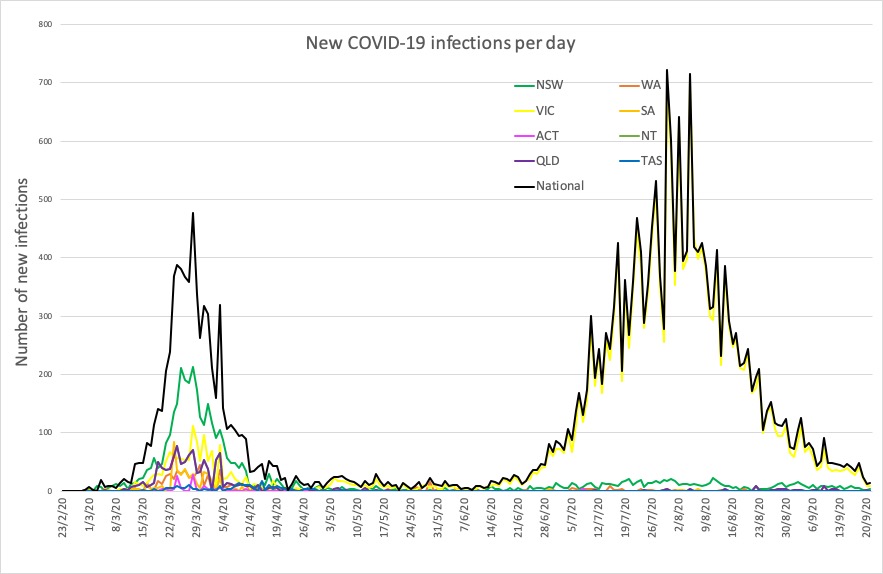Today we bring you the gymnastics event in Atlanta, as well as silk masks and sludge.
Welcome to The Medical Republic‘s COVID Catch-Up.
It’s the day’s COVID-19 news in one convenient post. Email bianca@biancanogrady.com with any tips, comments or feedback.
22 September
- US Centers for Disease Control flip-flops on airborne transmission of COVID-19.
- What do Mae West’s knickers and face-masks have in common?
- SARS-CoV-2 RNA in sewage appears days ahead of hospitalisations.
- Latest confirmed COVID-19 infection numbers from around Australia.
- The US Centers for Disease Control is having a bit of a brain-fart.
On Friday 18 September, the CDC executed a long-awaited about-face on the question of whether COVID-19 was spread via smaller, more airborne particles, and updated its advice on how COVID-19 spreads with this statement:
“COVID-19 may spread through the droplets and airborne particles that are formed when a person who has COVID-19 coughs, sneezes, sings, talks, or breathes. There is growing evidence that droplets and airborne particles can remain suspended in the air and be breathed in by others, and travel distances beyond 6 feet (for example, during choir practice, in restaurants, or in fitness classes). In general, indoor environments without good ventilation increase this risk.”
It was a fairly stunning change of heart, given the long-running battle between scientific experts wanting health organisations to acknowledge and act on the evidence for airborne (as opposed to just droplet and surface) transmission, and the health organisations defiantly not doing this.
Just when everyone was getting excited that the CDC was finally acknowledging the growing body of evidence supporting airborne transmission, the updated advice vanished from the CDC website, to be replaced with the statement: “A draft version of proposed changes to these recommendations was posted in error to the agency’s official website. CDC is currently updating its recommendations regarding airborne transmission of SARS-CoV-2 (the virus that causes COVID-19). Once this process has been completed, the update language will be posted.”
A CDC official told CNN that the airborne advice was posted prematurely by mistake; someone ‘hit the button and shouldn’t have’ (probably an intern who is now being roasted over a slow fire). The advice is apparently being revised, but there is no information on when the revised update will be posted. - Mae West famously boasted she was permitted to keep her own silk underwear during a 10-day stint in prison on obscenity charges. Had she lived during the time of COVID-19, she might have had very good reason to do so: research suggests silk makes excellent face mask fabric because of its hydrophobic, droplet-repelling qualities.
A paper published in PLOS ONE reports the analysis of the hydrophobicity of a range of fabrics – cotton, polyester and silk – with a view to examining how good they might be at repelling small and aerosolised water droplets, such as those that might transmit SARS-CoV-2.
The study found silk was far more hydrophobic than cotton or polyester, and its resistance to droplets and aerosols increased with more layers. The researcher suggested that silk could be layered over existing PPE to improve protection while also being washable (and comfortable, as Ms West would no doubt testify to). - SARS-CoV-2 RNA in sewage can be detected up to two days before positive tests in the local area, and one to four days in advance of COVID-19 cases presenting to hospitals, according to a study published in Nature Biotechnology.
Researchers collected daily samples of primary sewage sludge from a wastewater treatment facility that services around 200,000 residents in New Haven, Connecticut, from mid-March to the end of May.
They found the measures of SARS-CoV-2 RNA tracked the rise and fall of COVID-19 cases in the area, except during the very first week of testing, when RNA was discovered but there were not yet any diagnosed cases in the area. This suggested that positive specimens of SARS-CoV-2 RNA appeared in sewage up to two days before the first positive tests, and one to four days before the first hospital admissions.
“Thus, in communities where test reporting is delayed, sludge results, if analyzed and reported on the same day as sampling, can provide substantial advance notice of infection dynamics,” the authors wrote. - Here are the latest confirmed COVID-19 infection numbers from around Australia, to 9pm Monday:
National – 26,912, with 851 deaths
ACT – 113 (0)
NSW – 4204 (4)
NT – 33 (0)
QLD – 1153 (1)
SA – 466 (0)
TAS – 230 (0)
VIC – 20,051 (11)
WA – 662 (0)



